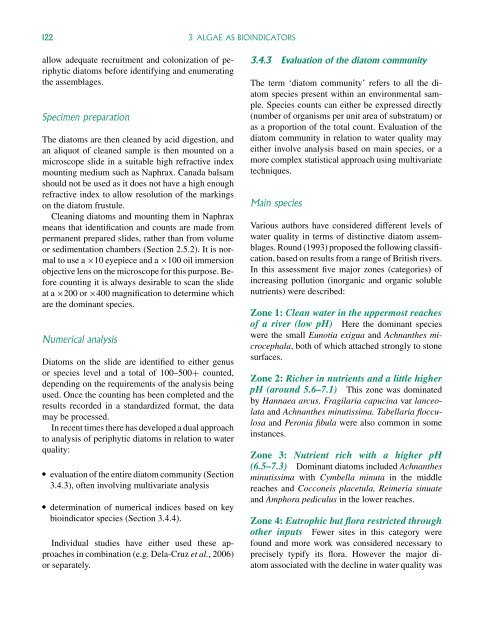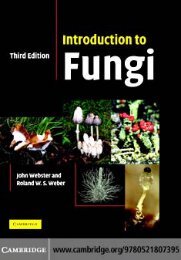Freshwater Algae: Identification and Use as Bioindicators
Freshwater Algae: Identification and Use as Bioindicators
Freshwater Algae: Identification and Use as Bioindicators
Create successful ePaper yourself
Turn your PDF publications into a flip-book with our unique Google optimized e-Paper software.
122 3 ALGAE AS BIOINDICATORSallow adequate recruitment <strong>and</strong> colonization of periphyticdiatoms before identifying <strong>and</strong> enumeratingthe <strong>as</strong>semblages.Specimen preparationThe diatoms are then cleaned by acid digestion, <strong>and</strong>an aliquot of cleaned sample is then mounted on amicroscope slide in a suitable high refractive indexmounting medium such <strong>as</strong> Naphrax. Canada balsamshould not be used <strong>as</strong> it does not have a high enoughrefractive index to allow resolution of the markingson the diatom frustule.Cleaning diatoms <strong>and</strong> mounting them in Naphraxmeans that identification <strong>and</strong> counts are made frompermanent prepared slides, rather than from volumeor sedimentation chambers (Section 2.5.2). It is normalto use a ×10 eyepiece <strong>and</strong> a ×100 oil immersionobjective lens on the microscope for this purpose. Beforecounting it is always desirable to scan the slideat a ×200 or ×400 magnification to determine whichare the dominant species.Numerical analysisDiatoms on the slide are identified to either genusor species level <strong>and</strong> a total of 100–500+ counted,depending on the requirements of the analysis beingused. Once the counting h<strong>as</strong> been completed <strong>and</strong> theresults recorded in a st<strong>and</strong>ardized format, the datamay be processed.In recent times there h<strong>as</strong> developed a dual approachto analysis of periphytic diatoms in relation to waterquality: evaluation of the entire diatom community (Section3.4.3), often involving multivariate analysis determination of numerical indices b<strong>as</strong>ed on keybioindicator species (Section 3.4.4).Individual studies have either used these approachesin combination (e.g. Dela-Cruz et al., 2006)or separately.3.4.3 Evaluation of the diatom communityThe term ‘diatom community’ refers to all the diatomspecies present within an environmental sample.Species counts can either be expressed directly(number of organisms per unit area of substratum) or<strong>as</strong> a proportion of the total count. Evaluation of thediatom community in relation to water quality mayeither involve analysis b<strong>as</strong>ed on main species, or amore complex statistical approach using multivariatetechniques.Main speciesVarious authors have considered different levels ofwater quality in terms of distinctive diatom <strong>as</strong>semblages.Round (1993) proposed the following cl<strong>as</strong>sification,b<strong>as</strong>ed on results from a range of British rivers.In this <strong>as</strong>sessment five major zones (categories) ofincre<strong>as</strong>ing pollution (inorganic <strong>and</strong> organic solublenutrients) were described:Zone 1: Clean water in the uppermost reachesof a river (low pH) Here the dominant specieswere the small Eunotia exigua <strong>and</strong> Achnanthes microcephala,both of which attached strongly to stonesurfaces.Zone 2: Richer in nutrients <strong>and</strong> a little higherpH (around 5.6–7.1) This zone w<strong>as</strong> dominatedby Hannaea arcus, Fragilaria capucina var lanceolata<strong>and</strong> Achnanthes minutissima. Tabellaria flocculosa<strong>and</strong> Peronia fibula were also common in someinstances.Zone 3: Nutrient rich with a higher pH(6.5–7.3) Dominant diatoms included Achnanthesminutissima with Cymbella minuta in the middlereaches <strong>and</strong> Cocconeis placetula, Reimeria sinuate<strong>and</strong> Amphora pediculus in the lower reaches.Zone 4: Eutrophic but flora restricted throughother inputs Fewer sites in this category werefound <strong>and</strong> more work w<strong>as</strong> considered necessary toprecisely typify its flora. However the major diatom<strong>as</strong>sociated with the decline in water quality w<strong>as</strong>
















